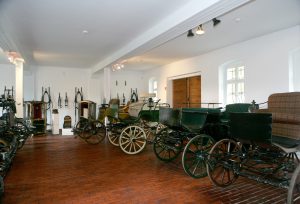 The uniqueness of the Raczynski family’s Rogalin residence is highlighted, among other things, by the art gallery created by Edward Aleksander Raczynski, a prominent art expert and longtime President of the Society of Friends of Fine Arts in Krakow. The purchases he made between the 1880s and 1920s created one of the finest collections of modern art in Poland, totalling nearly 500 works of art.
The uniqueness of the Raczynski family’s Rogalin residence is highlighted, among other things, by the art gallery created by Edward Aleksander Raczynski, a prominent art expert and longtime President of the Society of Friends of Fine Arts in Krakow. The purchases he made between the 1880s and 1920s created one of the finest collections of modern art in Poland, totalling nearly 500 works of art.
The idea to place the art in a publicly accessible building was Raczynski’s own right from the very beginning of his time as a collector. He ordered the first architectural designs of Stanislaw Borecki in 1896, soon after completion of the renovation of the ancestral palace. Ultimately, however, the gallery building was not erected until 1910 based on Mieczyslaw Powidz’s modernist design. The sacred interior of the gallery is in perfect harmony with the nature of the collections gathered there and hints at the same time at the destiny of this “temple of art” as a museum in which the role of the “image on the altar”, placed according to the Christian tradition on the eastern wall, is played by the monumental “Virgin of Orleans “, which is one of Jan Matejko’s most historic religious paintings.
This modern building, with light from above provided by a glass roof with a steel frame from H. Cegielski’s factory, was located beneath the southern wing of the palace. Thus, it didn’t compete with the existing residence, as access for visitors was possible from the lower part of the garden and the park while the residents and Raczynski’s guests were able to enter from the South outbuilding.
The gallery currently contains 250 of the approximately 300 items saved from the pre-war collection. Despite the gaps in the collection, stemming from the wartime losses, and a temporary exhibition of the selected works of Polish artists at the National Museum in Poznan, the current presentation gives an idea of the layout of the showroom created by its founder, for it is reconstructed on the basis of the Guide to the art gallery in Rogalin from about 1926 and archival photos.

So we have here an opportunity to get acquainted with Edward A. Raczynski’s concept of an exhibition, based on characteristic of nineteenth century styles of arrangement, consisting of hanging paintings in two, three, or even four rows. The interaction between the individual works and the showrooms indicate that one of the essential prerequisites of this concept was to show the diversity of art at the turn of the century, with particular emphasis on Polish painting flourishing at that time. This can be admired both in the entrance hall with its large group of realistic works by the Polish “Munchenians” and in the final and largest hall, which is dominated not only by the “Virgin of Orleans”, but also the most well-known, symbolic paintings of Jacek Malczewski and the works of a different character by A. Gierymski, W. Podkowiński, O. Boznańska, J. Fałat, L. Wyczółkowski, J. Mehoffer and W. Weiss. From this group only the numerous pastels of S. Wyspiariski, K. Sichulski and T. Axentowicz are excluded, which for reasons of conservation are now displayed in a specially darkened, small side room.
In three large, interconnected enfilade halls leading from the lobby to the largest gallery showroom the works of acclaimed European artists are displayed, mainly French, but also Belgian, Spanish, Norwegian and German, such as: A. Besnard, J.E. Blanche, E. Carrière, M. Chabas, A. Point, E. Claus, L. Simon, I. Zuloaga, F.J. Thaulow, F.v. Stuck, and M. Slevogt. This room of post-impressionist, naturalistic, neo-impressionist and symbolic works brings together the European achievements of the time and allow comparisons to be made with the Polish paintings.
The exhibition is complemented by sculptures, of which the bust of Edward A. Raczynski by E.M. Wittig deserves special attention. Next to him, in the entrance hall of the building, you can admire the stained glass “Carps” by L.C. Tiffany, a prominent American artist, who revolutionised the art of stained glass in his time.












